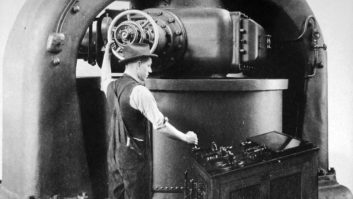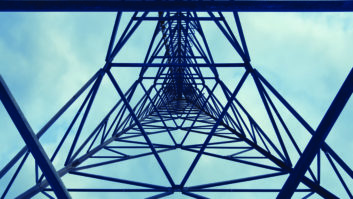Scott Dennis runs InfoTech Alaska in Anchorage. He tells about a studio technician who was training in RF. One day, visiting a transmitter site, the tech started to walk inside the fence of the 10 kW tower. Scott stopped him when the tech was about two feet from the tower.
To keep him mindful of RF, Scott then told the trainee to bring along a fluorescent tube on subsequent visits. The tech had to carry the tube with him as he got close to the fence.
It was particularly bright around his hand. The rule was that if the tube lit, the tech was to light out!
Scott had seen this trick at KJNP in North Pole, Alaska, “God’s 50,000-Watt Voice of the North.” The station mounts fluorescent tubes on the fences around the towers. It is an impressive visual demonstration of RF density.
Scott has mounted tubes at the base of AM towers to make sure everyone knows the towers are energized. I’ve also seen tubes used to provide added light when the staff is bridging a tower impedance in the absence of electricity for conventional lighting.
At AMs with collocated studios and transmitters, the bulbs make an impressive demonstration of how radio waves propagate. Hold the bulb close to the transmitter output, then draw the bulb away from the RF source. The dimming of the light corresponds with the weaker RF the further you get from the transmitter.
Such demonstrations also earn the respect of your staff. I remember one sales manager’s eyes popping out when he saw me holding this “lit” fluorescent tube, not connected to any AC source. It’s a great demonstration for Cub Scout and Brownie tours, too.
. . .
(click thumbnail)Figure 1. Spring is a great time to weatherproof your transmitter site…
Spring is a great time to consider weatherproofing your transmitter site. A can of expanding foam will keep weather as well as insects and rodents out of the transmitter building. Don’t forget outside coupling unit boxes.
Fig. 1 shows a gap between the doorframe and cinderblock wall, properly sealed. It’s important, however, that the person doing the sealing have a little common sense. Fig. 2 shows what happens when an unsupervised intern is turned loose with a can of expanding foam. He decided to plug the hole from the outside. “It just keeps takin’ the foam, boss!”
(click thumbnail)Figure 2. … but don’t overdo it from outside. ‘It just keeps takin’ the foam, boss!’
Hey, at least the inside of the cinder blocks are insulated too.


. . .
If your SBE chapter is looking for a great meeting, contact the folks at Fluke Corp.
The company has announced its training course schedule for the year. A copy can be obtained at (800) 44-FLUKE or online at www.fluke.com/2003caltraining.
Test equipment manufacturers and their reps are great sources for interesting and relevant SBE programs.
. . .
In the Feb. 1 Workbench, we related an anecdote about an FCC inspector who wanted to do harmonic measurements in the null of a directional array.
Sheldon Daitch is with the International Broadcasting Bureau in Washington. Funny as our story was, Sheldon inquires how a series of harmonic measurements should be performed when an AM station uses a directional array.
I’d always heard that such measurements should be made in the major lobe, as described by the station’s RF proof. Sheldon writes that it seems simple to make these measurements with a non-directional facility; but for the same reason that the harmonic radiation content in the null does not match the harmonic levels produced by the transmitter, how does one select the proper point to measure harmonics when the facility has a directional array?
He speculates that you could go around the pattern and take several measurements. But who’s to decide if some don’t meet spec?
. . .
If the lit fluorescent tube mentioned earlier doesn’t earn some respect, maybe the hawk’s claws in Fig. 3 will.
Bill Tennant, chief engineer with Moody Broadcasting in Chicago, encountered this grisly sight. The claws are gripping the slant-wire AM feed on WMBI’s old tower. The bird’s right wing must have made contact with the grounded tuning box, which is out of the frame of the picture.
(click thumbnail)Figure 3. This is an unpleasant reminder that we work with lethal voltages in radio.
The hawk was not to be found. Was he vaporized?
I worked at one of the first folded unipole AMs here in Washington. In fact, the father of the folded unipole, John Mullaney Sr., did much of his unipole design work at this station, which was then WPIK. Jack Mullaney, John H.’s son, continues his father’s work with Mullaney Engineering.
There are a number of advantages to using unipoles for AM, but the sometimes-high voltages at the base feed point demand that safety be exercised.
To give you an idea of the voltages developed in these feeds, at WPIK there was a sign next to the vacuum output capacitor. It said the voltage had been measured at that point and it pegged a 50 kV full-scale meter, the highest-range meter they had available at the time.
One day, during a routine transmitter inspection, my assistant discovered a small set of bird’s feet, perhaps belonging to a sparrow or starling. As in Fig. 3, the bird was gone; just the feet remained.
The moral to these stories is that we work with lethal voltages and we must never take our duties for granted or let safety take a break. There’s a reason the FCC gets so upset at operators who don’t have fences around their towers.













